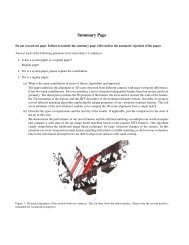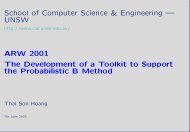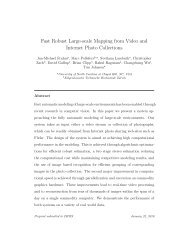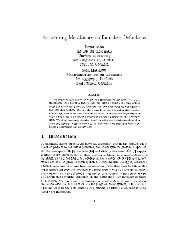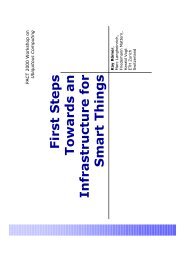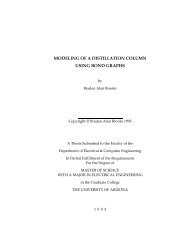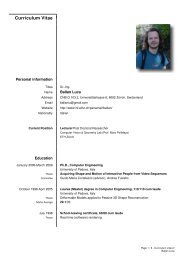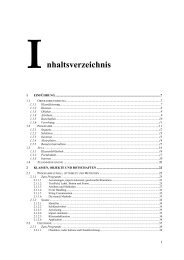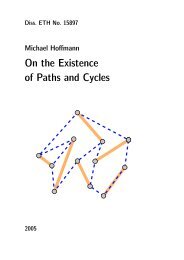A CIL Tutorial - Department of Computer Science - ETH Zürich
A CIL Tutorial - Department of Computer Science - ETH Zürich
A CIL Tutorial - Department of Computer Science - ETH Zürich
You also want an ePaper? Increase the reach of your titles
YUMPU automatically turns print PDFs into web optimized ePapers that Google loves.
Chapter 11<br />
Program Verication<br />
In this tutorial, we will use the Why3 [3] verication framework to prove things about C code. In<br />
particular we will generate verication conditions (VCs) from preconditions, postconditions, and<br />
loop invariants given by an annotation syntax that we will add to C using function type attributes<br />
and block attributes. Suppose a function f is annotated with precondition pre and postcondition<br />
post. We ask Why3 to prove the validity <strong>of</strong> pre → V C(f, post).<br />
An introduction to the generation <strong>of</strong> verication conditions for imperative languages can be<br />
found in the textbook by Winskel [6]. In this example we will use the backwards method <strong>of</strong> VC<br />
generation. This will preclude a straightforward handling <strong>of</strong> C constructs like goto, break, and<br />
continue statements. For these, a forwards method <strong>of</strong> VC generation is more suitable. However,<br />
the backwards method is able to handle all the other features <strong>of</strong> C including while loops, for loops,<br />
if statements, and switch statements.<br />
This module allows expression preconditions, postconditions, and loop invariants in C code with<br />
syntax extensions embodied in the following example:<br />
void (pre(p1) post(p2) f)(...) {<br />
while(c) { invariant(c, p3, v1, ..., vn)<br />
}<br />
}<br />
Here, p1, p2, and p3 are propositions that may include universal quantications and implications.<br />
Universal quantication is written as forall(v1,...,vn,p) where v1 through vn are the<br />
variables being quantied over, and p is the formula being quantied over. Implication is written<br />
as implies(p1,p2), where p1 is the antecedent and p2 is the consequent. In the loop invariant annotation,<br />
c is the loop termination condition, p3 is the loop invariant proposition, and v1 through<br />
textttvn are the loop variant variables. Except for forall and implies, C expression syntax is<br />
used for the propositions.<br />
91



